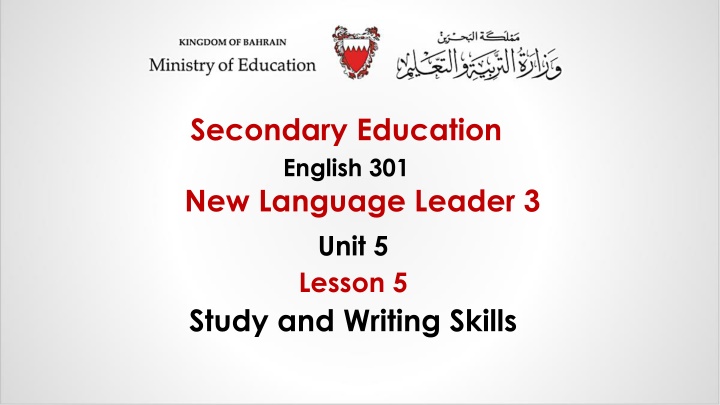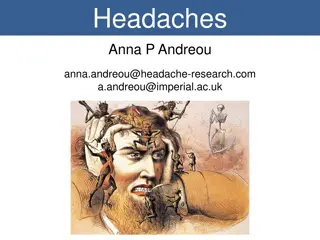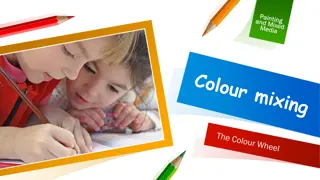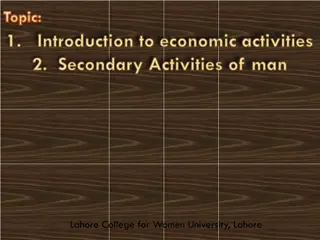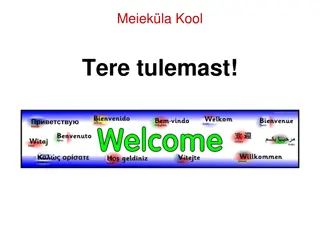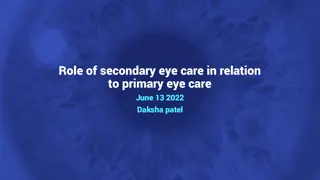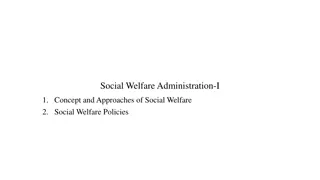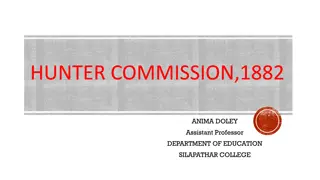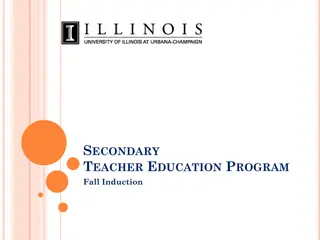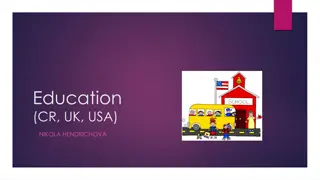Secondary Education
Communication is crucial in establishing relationships, sharing ideas, and managing teams. Verbal, nonverbal, written, and visual communication play vital roles in conveying information effectively. Understanding these communication types helps in building strong connections and enhancing collaboration.
Download Presentation

Please find below an Image/Link to download the presentation.
The content on the website is provided AS IS for your information and personal use only. It may not be sold, licensed, or shared on other websites without obtaining consent from the author.If you encounter any issues during the download, it is possible that the publisher has removed the file from their server.
You are allowed to download the files provided on this website for personal or commercial use, subject to the condition that they are used lawfully. All files are the property of their respective owners.
The content on the website is provided AS IS for your information and personal use only. It may not be sold, licensed, or shared on other websites without obtaining consent from the author.
E N D
Presentation Transcript
Secondary Education English 301 New Language Leader 3 Unit 5 Lesson 5 Study and Writing Skills
Eng.301 Unit 5 Lesson 5- Study and Writing Skills Objectives By the end of the lesson, you will be able to identify types of graphs and charts and their importance, practise using specific vocabulary related to graphs, practise interpreting and representing information and statistics in graphs and charts, create a pie chart and bar graph, revise phrases for comparing and contrasting information and statistics, write a summary of statistics found in tables.
Ways to Communicate Information Based on what you covered in unit 1, fill in the blanks with the words in the box below to complete the meaning. facial convey both consume enjoyable aid record conferences printing speaking feelings relationships Whether you give a slight head nod in agreement or present information to a large group, communication is absolutely necessary when building ____________, sharing ideas, delegating responsibilities, managing a team and much more. There are four main types of communication we use on a daily basis: verbal, nonverbal, written and visual. First, verbal communication is the use of language to transfer information through _____________or sign language. It is one of the most common types often used during presentations, video _____________and phone calls, meetings and one-on-one conversations. Second, nonverbal communication is the use of body language, gestures and _____________expressions to convey information to others. It can be used __________intentionally and unintentionally. For example, you might smile unintentionally when you hear a pleasing or an ____________idea or a piece of information. Nonverbal communication is helpful when trying to understand others thoughts and___________. Third, written communication is the act of writing, typing or ____________symbols like letters and numbers to convey information. It is helpful because it provides a _________of information for reference. Finally, visual communication is the act of using photographs, art, drawings, sketches, charts and graphs to ________information. Visuals are often used as an _______during presentations to provide helpful context alongside written and/or verbal communication. Because people have different learning styles, visual communication might be more helpful for some to _________ideas and information. Eng.301 Unit 5 Lesson 5- Study and Writing Skills
Now, check your answers facial convey both consume enjoyable aid record conferences printing speaking feelings relationships Whether you give a slight head nod in agreement or present information to a large group, communication is absolutely necessary when building______________, sharing ideas, delegating responsibilities, managing a team and much more. There are four main types of communication we use on a daily basis: verbal, nonverbal, written and visual. First, verbal communication is the use of language to transfer information through ____________or sign language. It is one of the most common types, often used during presentations, video ____________and phone calls, meetings and one-on-one conversations. Second, nonverbal communication is the use of body language, gestures and ___________expressions to convey information to others. It can be used _______intentionally and unintentionally. For example, you might smile unintentionally when you hear a pleasing or an __________idea or piece of information. Nonverbal communication is helpful when trying to understand others thoughts and__________. Third, written communication is the act of writing, typing or _________symbols like letters and numbers to convey information. It is helpful because it provides a _________of information for reference. Finally, visual communication is the act of using photographs, art, drawings, sketches, charts and graphs to _________information. Visuals are often used as an ________during presentations to provide helpful context alongside written and/or verbal communication. Because people have different learning styles, visual communication might be more helpful for some to __________ideas and information. consume relationships speaking conferences facial both enjoyable feelings printing record convey aid Eng.301 Unit 5 Lesson 5- Study and Writing Skills
VISUAL COMMUNICATION In this presentation you are going to learn how to read charts, graphs and tables and identify the key features of each of them. Reading comprehension involves more than reading words. Informational texts such as textbooks, manuals and newspapers often contain graphical elements, e.g., tables, illustrations, diagrams and timelines. Students who can interpret graphical elements have an advantage over those who cannot. Charts Pie charts are used to show proportions and how each piece relates to the whole. Use pie charts only when the parts of the pie are mutually exclusive categories and the sum of parts adds up to a meaningful whole (100% of something). Graphs Bar graphs present a set of bars. Each bar stands for a specific quantity, amount or measurement. Bar graphs are also used to display proportions. Tables Tables present facts or figures displayed in columns and rows. Information in the title and headings (labels) tell what the columns and rows represent. Titles go above the body of the table and are left-justified. Eng.301 Unit 5 Lesson 5- Study and Writing Skills
Read the report by The United Nations World Tourism Organization and create a pie chart and bar graph to illustrate the information in paragraph 3. Once you are done click the enter key to check your answers on the next two slides. Countries that attract travellers the most 1 The United Nations World Tourism Organization (UNWTO) publishes a report on travel and tourism around the world annually, and the 2018 edition has just been released. The study looks at trends in tourism around the world and, among other measures, tracks increases and decreases in tourism activity in countries and regions. Here's what this year's study has found out. 2 In total, international tourists rose to just over 1.3 billion in 2017, 6.8% more than in 2016. This is the largest percentage increase in a year since 2009. The two regions that experienced the most growth were Africa (9%) and Europe (8%). What is surprising about these figures is that Europe received more than half of international tourist arrivals worldwide, or 671 million, while Africa received less than a tenth of that. amount, only 63 million. 3 European travellers accounted for 48% of tourism, followed by those from Asia-Pacific (25%), the Americas (17%), the Middle East (3%), Africa (3%); and 4% did not declare their origin. 4 International tourism spending also increased 5% worldwide to $ 1.34 billion. Almost 40% of this figure comes from spending in Europe, followed by Asia-Pacific (29%) and the Americas (24%). Eng.301 Unit 5 Lesson 5- Study and Writing Skills
Now, check your answers Eng.301 Unit 5 Lesson 5- Study and Writing Skills
Writing: Describing information in a table The tables below show the cost of living of the United States of America and Canada. Summarise the information in the tables by selecting and reporting the main features. Make comparisons where relevant. Table 2: Price of selected items USA $ 0.99 $91.29 $0.96 $10.00 Canada $1.80 $76.09 $1.17 $10.79 Table 1: Average Salary and Rent Milk > 1 litre prices > Shoes petrol > 1 litre Cinema ticket Public transport > USA $3,259 Canada $2,773 Average salary Rent per month 1 > bedroom apartment $745 $744 $ 2.00 $2.70 One way ticket Eng.301 Unit 5 Lesson 5- Study and Writing Skills
How to Describe a Graph, Diagram, Chart or Table? Highlight the main features of a graph, diagram, chart or table, leaving out minor details and irrelevant information. Paraphrase wherever possible. Put any useful terms or phrases that are given in the title or labels into your own words. Use synonyms, but also restructure your sentences. Avoid sentences like: I/We can see that I think it s an interesting feature that Instead, use impersonal pronouns and structures such as the passive voice: It can be seen that A striking feature of the graph is Use Appropriate Language First of all, you should not use any informal or slang words or expressions in the Writing exam keep the vocabulary formal and academic. Make Sure What You Say is True (according to the given data) Do Not Give Your Opinion. Eng.301 Unit 5 Lesson 5- Study and Writing Skills
Here are some useful phrases/ expressions to describe charts. As every graph tells a story, the designer has to be a good story teller. Some vocabulary you need to know: The pie chart is about ... The bar chart deals with ... The line graph (clearly) shows ... The diagram outlines This graph shows This table lists This chart represents This chart depicts This chart breaks down The slices of the pie chart compare the ... The chart is divided into ... parts. It highlights ... ... has the largest (number of) ... ... has the second largest (number of) ... Let me show you Let s have a look at Let s turn to To illustrate my point let s look at As you can see from these To go up: increase, rise, rocket, climb, lift, grow, go up, etc. To go down: decrease, drop, decline, fall, go down, a fall, a decrease etc. No change: remain stable/ constant/ steady at, stay at the same level etc. Indicating a change of direction: stand at, stop falling/rising, stop falling and start rising, stop rising and start falling, change etc. At the top: reach a peak, peak, reach its/ their highest point etc. At the bottom: reach/hit a low (point), hit/ reach its/ their lowest point etc. Use of Tenses Mind the correct use of tenses when describing a chart. If the charts deals with facts in the present , use the Simple Present If the facts are in the past, then use the Simple Past. If there is a connection between the past and the present, use the Present Perfect. Eng.301 Unit 5 Lesson 5- Study and Writing Skills
Place the words in the right column. Once you are done, click the enter key to check your answers. constant climb substantial dramatic collapse cut sharp stand at expansion considerable extension fall go down growth improvement minimal level off push down steep reduction rise soar stability moderate stagnation huge slight Verbs Nouns Adjectives collapse climb constant collapse expansion substantial extension dramatic cut sharp fall standat growth considerable fall minimal improvement go down steep level off reduction rise slight push down rise stability moderate stagnation soar huge Eng.301 Unit 5 Lesson 5- Study and Writing Skills
Place the words in the right column to express the movement of a line. constant climb collapse stand at expansion fall go down growth improvement level off push down reduction rise stagnation increase expand step-up maintain recover hold steady extension stability level off decrease drop stay at take-off crash rocket slide plunge decline remain stable downturn collapse climb expansion constant stand at fall improvement go down growth level off push down stagnation hold steady maintain rise increase decrease reduction expand step-up level off drop stability stay at crash recover extension slide remain stable plunge rocket take-off decline downturn Eng.301 Unit 5 Lesson 5- Study and Writing Skills
The General Format of the Writing is as below: You should write an introduction: Try to write a meaningful introduction. You should explain the basic or the general trends in detail: Here you get a chance to exhibit your range of vocabulary. You should write an appropriate and meaningful conclusion . Remember Describing a specific set of information given in a table does not differ from describing a graph or pie chart. Keep in mind that: You must write your explanation in not less than 150 words and preferably not exceeding 200 words. You should not speculate or give opinions on the data you are simply expected to describe the data given. No more. The writing process should be followed: pre-writing (generating ideas and organizing them), writing, reviewing and editing. Now, it s your turn to describe the information in the tables on slide 09. Eng.301 Unit 5 Lesson 5- Study and Writing Skills
Lets go through the writing question again The tables below show the cost of living of the United States of America and Canada. Summarise the information in the tables by selecting and reporting the main features. Make comparisons where relevant. Table 2: Price of selected items Table 1: Average Salary and Rent USA $ 0.99 $91.29 $0.96 $10.00 Canada $1.80 $76.09 $1.17 $10.79 USA $3,259 Canada $2,773 Milk > 1 litre prices > Shoes petrol > 1 litre Cinema ticket Public transport > Average salary Rent per month 1 > bedroom apartment $745 $744 $ 2.00 $2.70 One way ticket REMEMBER Use comparative and superlative adjectives when you want to compare and contrast things. Eng.301 Unit 5 Lesson 5- Study and Writing Skills
Lets check! Complete the following sentences with the correct comparative form of the words listed below. bad important crowded good high heavy convenient difficult cheap expensive quiet easy thin healthy dangerous cold 1. In Canada, January is ________________ than March. 2. I think that good health is _______________________ than money. 3. I can t carry my suitcase. It s much ______________________ than yours. 4. I can afford to buy a new bike but not a new car. A car is _______________________ than a bike. 5. You look ________________than the last time I saw you. Have you lost weight? 6. I couldn t get a seat in the restaurant. It was _____________________than usual. 7. Mountains are _______________ than hills. 8. He got a very good mark on his exam. The exam was _______________ than he had expected. 9. You should go to the doctor. Your cold is __________________ than it was a few days ago. 10. There is a lot of crime in the big cities. They are __________________than the small towns where I live. 11. I don t understand this lesson. It is ___________________than the last one we had. 12. I can t study in this room. It s too noisy. I m going to find a _________________place. 13. Our apartment is far from everything. We want to move to a __________________ location. 14. Orange juice is _______________than soda. 15. The store is having a great sale today. Most televisions are 25% ______________ than they were yesterday. 16. The doctor told me that I can go back to work if I feel _______________tomorrow. colder more important heavier moreexpensive thinner more crowded higher easier worse more dangerous more difficult quieter more convenient healthier cheaper better Eng.301 Unit 5 Lesson 5- Study and Writing Skills
Self-assessment checklist. Task Response: Is the description between 150 and 200 words? Is the task clearly identified in the introduction? Have the important details in the data been referred to? Coherence & Cohesion: Is the information grouped into clear paragraphs? Is the information presented in a logical order? Are the sentences well-linked together? Has correct punctuation been used? Lexical Resource: Has the question been suitably paraphrased? Has repetition of vocabulary been avoided? Does the text contain vocabulary specific to the topic? Grammar Range & Accuracy: Has spelling been checked? Have verb tenses and subject verb agreement been checked? Eng.301 Unit 5 Lesson 5- Study and Writing Skills
Here is a model answer. Some researches were done into the similarities and differences between the USA and Canada. Data was collected from many sources. Information from websites such as Nation Master was used. The results were analyzed. Then some of the results were put into tables. The results are shown in Tables 1 and 2. We can see from Table 1 that there is quite a big difference in the average monthly salaries in the two countries. Americans take home, on average, $3,259 a month whereas Canadians get $2,773. However, the average monthly rent for a one bedroom apartment, for example, is nearly the same in both countries. There are some differences in the prices of everyday items. Table 2 shows that, for example, a litre of milk is much cheaper in the USA while the average price of a pair of shoes is more expensive in the USA for $91.29 against $76.09 in Canada. However, a litre of petrol is quite cheaper in the USA, while a cinema ticket is almost the same price in both countries . However, a one way ticket for public transport is quite more expensive in Canada for $3.00 against $ 2.00 in the USA. When it comes to life costs, there are many differences between Canada and the USA. As a conclusion, there are several similarities and differences between the USA and Canada. However, it is clear that life in Canada is more expensive that that in the USA. Eng.301 Unit 5 Lesson 5- Study and Writing Skills
THIS IS THE END OF THE LESSON THANK YOU FOR YOUR ATTENTION AND HARD WORK Eng.301 Unit 5 Lesson 5- Study and Writing Skills
